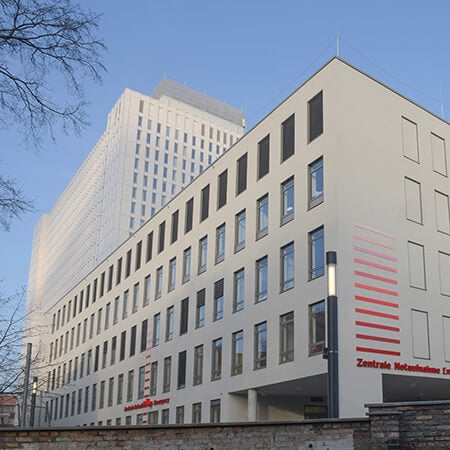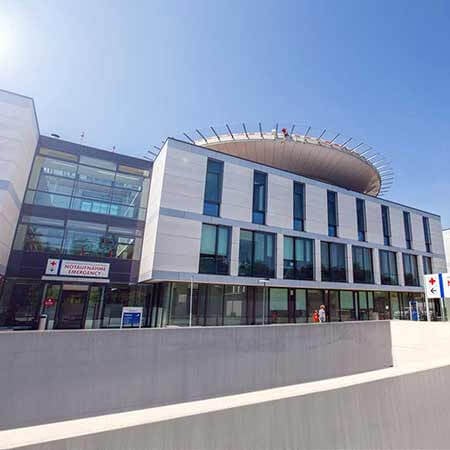Brain Aneurysm: Diagnostic in the Best Hospitals in the World
Treatment prices are regulated by national law of the corresponding countries, but can also include additional hospital coefficients. In order to receive the individual cost calculation, please send us the request and medical records.

Department of Adult and Pediatric Neurosurgery, Spinal Surgery
The Department of Adult and Pediatric Neurosurgery, Spinal Surgery offers all the possibilities of modern surgical treatment for diseases of the central and peripheral nervous system in patients of all ages. More than 6,000 surgical procedures are performed annually in the department's high-tech operating rooms. Both planned and emergency neurosurgical procedures are performed here. The department's surgical team focuses on patients with cerebrovascular diseases, brain and skull base tumors, spine and spinal cord diseases, cerebrospinal fluid circulation disorders, and pathologies of the peripheral nervous system. The department's team of physicians also has extensive experience in functional neurosurgery: specialists perform deep brain stimulation for movement disorders, spinal cord stimulation for back pain, and vagus nerve stimulation for epilepsy. The department works closely with neurologists, radiologists, and nuclear medicine specialists to provide patients with the highest level of comprehensive medical care. The department is recognized as one of the top neurosurgical centers in Germany and beyond, as evidenced by consistently high treatment success rates and numerous quality certifications, including the German Cancer Society (DKG) Certificate, the German Spine Society (DWG) Certificate, and the Leading Medicine Guide Certificate.







Department of Adult and Pediatric Neurosurgery
The Department of Adult and Pediatric Neurosurgery offers the full range of surgical treatment of diseases of the brain, spine, spinal cord and nerves in adults and children. The department keeps pace with new trends in medicine, as well as contributes significantly to their development. Therefore, the most modern diagnostic and therapeutic methods are available here. An individual approach to each clinical case is crucial to ensure optimal treatment results with the preservation of all neurological functions.


Department of Adult and Pediatric Neurosurgery
According to the Focus magazine, the Department of Adult and Pediatric Neurosurgery ranks among the top German medical facilities specializing in the surgical treatment of brain tumors! The department offers the full range of diagnostics and surgical treatment of diseases of the central and peripheral nervous system. A specially trained team of pediatric neurosurgeons provides treatment for various neurosurgical pathologies in children. During the treatment, the doctors use state-of-the-art equipment, in particular, imaging-guided neuronavigation, functional imaging (fMRI), intraoperative mapping, intraoperative videoangiography, etc.






Brain aneurysms are local dilatations in cerebral arteries. A saccular-shaped bulge is the most common type of lesion. A blood vessel wall in the area of an aneurysm is weak and may rupture if the blood pressure rises. For this reason, an aneurysm is a frequent cause of intracerebral hemorrhage. It is important to detect the pathology early enough in order to decide whether the aneurysm is dangerous and whether it needs to be removed. Neurosurgery plays a crucial role in the diagnosis, management, and treatment of brain aneurysms.
Content
- Why is it important to detect an aneurysm early?
- Neurosurgical treatment options after diagnosis
- Where can I get diagnosed and treated?
Why is it important to detect an aneurysm early?
Most brain aneurysms do not cause any symptoms. These intracranial lesions can only be detected during regular screenings of asymptomatic patients, or they can be found by chance during examinations for other diseases of the central nervous system.
Brain aneurysm symptoms occur in only two cases:
- Giant aneurysms – they can put excess pressure on surrounding tissues, imitating brain and spinal cord tumors
- Subarachnoid hemorrhage – an aneurysm ruptures, causing hemorrhage and neurological symptoms
It is better to detect an aneurysm at an early stage to avoid subarachnoid hemorrhage, as this often leads to disability or death. The following modern methods of neurosurgical diagnostics are used in developed countries:
- A MRI scan enables the detection of even small aneurysms in asymptomatic patients.
- A contrast-enhanced CT scan is the main diagnostic method for suspected hemorrhage.
- Cerebral angiography – contrast-enhanced X-ray imaging. This is the most accurate examination method, but it is invasive (arterial catheterization is required), which is why it can be usually applied in the treatment planning phase or after a hemorrhage.
European clinics use the latest neuronavigation technology to plan neurosurgical treatment. Patients undergo CT and MRI scans for brain with the markers attached to their heads. Afterwards, the medical image data is entered into a navigation system, which transfers it into a virtual coordinate system. An infrared camera reads the markers and matches the CT or MRI data with the position of the patient's head. During the operation, the surgeon can switch back and forth between the image of the surgical microscope, the virtual image of the neuronavigation system, and the real image, overlaying them on top of each other. The result is excellent precision and safety of surgical procedures.
Neuronavigation technology is used for brain and spinal cord diagnostics in case of any structural changes in these areas. Before spinal cord surgery, images are created using 3D X-ray scanning.
Neurosurgical treatment options after diagnosis
Once an aneurysm has been discovered, a decision should be made as to whether the patient needs treatment. This decision depends on the size and location of the aneurysm, the expected difficulties in removing it, the patient's age, concurrent diseases, and other factors.
Despite the high level of patient safety in neurosurgery provided in developed countries, brain surgeries carry some risks. Therefore, an aneurysm can only be removed if it has become dangerous and the risk of rupture associated with subarachnoid hemorrhage is evaluated as high. In other cases, the patient is kept under medical supervision.
If the aneurysm is not growing, no treatment is needed. Should it grow rapidly or reach a large size, the person needs to undergo surgery. The main methods include neurosurgical treatment options (resection or clipping of aneurysms) and endovascular repair (endovascular coiling of aneurysms).
Endovascular repair is a less traumatic procedure and does not require prolonged rehabilitation. It is performed from inside the blood vessel through a small incision in the groin. Surgeons embolize the aneurysm to cut it off from blood flow. However, this type of treatment is more complex, and neurosurgical success rates may vary significantly. It is also important to select the right patients who are suitable for this type of procedure, depending on the location, size, and structure of the aneurysm. In specialized centers located in developed countries, the procedure has been shown to be successful in more than 80% of cases, allowing patients to avoid neurosurgery.
Neurosurgical repair is unavoidable for large or endovascularly unfavorably located aneurysms. The neurosurgical success rates in German clinics come almost to 100 percent. During this procedure, a small metal clip is attached at the base of the aneurysm to cut it off from the blood flow.
Where can I get diagnosed and treated?
You can seek medical help from one of the German hospitals. The benefits of treatment in German clinics are as follows:
- High-precision diagnostics based on state-of-the-art equipment
- High success rates for endovascular treatments
- Advanced neuronavigation systems and powerful surgical microscopes that improve the efficiency and safety of neurosurgical interventions
- Experienced doctors who annually perform dozens of surgeries and procedures to treat brain vascular malformations
- Individual approach to treatment planning
- Quality nursing staff and patient-centered care
You are welcome to use our website to check the prices for medical services, compare the costs of examinations and treatments in different hospitals, and choose a suitable option. We are happy to help you make an appointment at your convenience, get advice from our medical tourism specialists, and have your trip organized by our travel management office. Making an appointment through Booking Health means that the average cost of treatment will be lower than going directly to a medical center, as no additional fees are charged to international patients.
Authors:
The article was edited by medical experts, board certified doctors Dr. Nadezhda Ivanisova and Dr. Vadim Zhiliuk. For the treatment of the conditions referred to in the article, you must consult a doctor; the information in the article is not intended for self-medication!
Our editorial policy, which details our commitment to accuracy and transparency, is available here. Click this link to review our policies.
Sources:

